Conversion of Argan Nutshells into Novel Porous Carbons in the Scope of Circular Economy: Adsorption Performance of Emerging Contaminants
Abstract
:1. Introduction
2. Materials and Methods
2.1. Raw Materials
2.2. Porous Carbons Synthesis
2.3. Porous Carbons Characterization
- Elemental analysis—Quantification of C, H, N, and S (Thermo Finnigan-CE Instruments Flash EA 1112 CHNS analyzer, Waltham, MA, USA);
- Ash content—Residue after combustion at 750 °C for 6 h in a muffle furnace (ASTM D1762);
- pH at the point of zero-charge (pHPZC)—A series of 6 solutions of NaCl (0.01 mol L−1, 20 mL) was prepared, and the pH of each solution was adjusted in the range of 2–12 by adding 0.1 M NaOH or 0.1 M HCl. Then, 0.05 g of the carbon was added to each solution, agitated for 48 h, and the final pH of each solution was measured. The pHPZC was obtained from the plot of pHdrift versus pHinitial;
- Thermogravimetric analysis (TGA)—Mass loss between 30 and 900 °C (heating rate of 5 °C min−1) under argon atmosphere (Setaram Labsys EVO, France);
- Fourier-Transform Infrared Spectroscopy (FTIR)—KBr disk method (Perkin-Elmer Spectrum 1000 Spectrometer, Waltham, MA, USA) in the range of 400–4000 cm−1 (resolution of 1 cm−1);
- X-ray Photoelectron Spectroscopy (XPS)—XPS of the carbon surface was obtained by using the Mg Kα radiation (hν = 1253.6 eV) from an XSAM800 dual anode spectrometer from Kratos. The operation conditions of the XPS analysis were as described in [30]. The detailed regions C 1s, O 1s, N 1s, and S 2p were acquired;
- Temperature programmed desorption (TPD)—100 mg of each sample was heated to 1100 °C (heating rate of 5 °C min−1) under a flow rate of 25 cm3 min−1 of He. The profiles of CO and CO2 were obtained with automated AMI-300 equipment (Altamira Instruments) connected to a mass spectrometer (Dymaxion 200, Ametek, PA, USA). Quantification of CO and CO2 released through calibration at the end of each experiment;
- Scanning Electron Microscopy with Energy Dispersive Spectroscopy (SEM-EDS)—The morphology and elemental composition of ACK were obtained by using a JEOL 7001F analytical FEG-SEM equipment with an energy-dispersive X-ray spectrometer light element detector attachment.
2.4. Batch Adsorption Studies
2.5. Desorption Studies
3. Results and Discussion
3.1. Porous Carbons Characterization
3.1.1. N2 Adsorption-Desorption Isotherms and Pore Size Distribution
3.1.2. Elemental Analysis and Ash Content
3.1.3. Thermogravimetric Analysis (TGA)
3.1.4. FTIR Analysis
3.1.5. XPS Analysis
3.1.6. TPD Analysis
3.1.7. SEM-EDS
3.2. DCF and PARX Adsorption Assays
3.2.1. Effect of Initial pH
3.2.2. Kinetic Study
3.2.3. Adsorption Equilibrium Studies
3.2.4. Temperature Effect
3.2.5. Adsorption Mechanisms
3.2.6. Desorption Studies
4. Conclusions
Supplementary Materials
Author Contributions
Funding
Institutional Review Board Statement
Informed Consent Statement
Data Availability Statement
Acknowledgments
Conflicts of Interest
References
- Dias, J.M.; Alvim-ferraz, M.C.M.; Almeida, M.F.; Sa, M. Waste materials for activated carbon preparation and its use in aqueous-phase treatment: A review. J. Environ. Manag. 2007, 85, 833–846. [Google Scholar] [CrossRef] [PubMed]
- Abuelnoor, N.; Alhajaj, A.; Khaleel, M.; Vega, L.F.; Abu-Zahra, M.R.M. Activated carbons from biomass-based sources for CO2 capture applications. Chemosphere 2021, 282, 131111. [Google Scholar] [CrossRef] [PubMed]
- Da Silva Santos, D.H.; Paulino, J.C.P.L.; dos Santos Alves, G.F.; de Magalhães Oliveira, L.M.T.; de Carvalho Nagliate, P.; da Silva Duarte, J.L.; Meili, L.; Tonholo, J.; Silva Zanta, C.L.P. Effluent treatment using activated carbon adsorbents: A bibliometric analysis of recent literature. Environ. Sci. Pollut. Res. 2021, 28, 32224–32235. [Google Scholar] [CrossRef]
- González-García, P. Activated carbon from lignocellulosics precursors: A review of the synthesis methods, characterization techniques and applications. Renew. Sustain. Energy Rev. 2018, 82, 1393–1414. [Google Scholar] [CrossRef]
- Valero-romero, M.J.; Rodríguez-cano, M.Á.; Palomo, J. Carbon-Based Materials as Catalyst Supports for Fischer—Tropsch Synthesis: A Review. Front. Mater. 2021, 7, 617432. [Google Scholar] [CrossRef]
- Tan, X.F.; Liu, S.-B.; Liu, Y.-G.; Gu, Y.-L.; Zeng, G.-M.; Hu, X.-J.; Wang, X.; Liu, S.-H.; Jiang, L.-H. Biochar as potential sustainable precursors for activated carbon production: Multiple applications in environmental protection and energy storage. Bioresour. Technol. 2017, 227, 359–372. [Google Scholar] [CrossRef] [PubMed]
- Thomas, P.; Lai, C.W.; Bin Johan, M.R. Recent developments in biomass-derived carbon as a potential sustainable material for super-capacitor-based energy storage and environmental applications. J. Anal. Appl. Pyrolysis 2019, 140, 54–85. [Google Scholar] [CrossRef]
- Yahya, M.A.; Al-Qodah, Z.; Ngah, C.W.Z. Agricultural bio-waste materials as potential sustainable precursors used for activated carbon production: A review. Renew. Sustain. Energy Rev. 2015, 46, 218–235. [Google Scholar] [CrossRef]
- Ben Mansour, R.; Ben Slema, H.; Falleh, H.; Tounsi, M.; Kechebar, M.S.A.; Ksouri, R.; Megdiche-Ksouri, W. Phytochemical characteristics, antioxidant, and health properties of roasted and unroasted Algerian argan (Argania spinosa) oil. J. Food Biochem. 2018, 42, e12562. [Google Scholar] [CrossRef]
- Koufan, M.; Belkoura, I.; Mazri, M.A.; Amarraque, A.; Essatte, A.; Elhorri, H.; Zaddoug, F.; Alaoui, T. Determination of antioxidant activity, total phenolics and fatty acids in essential oils and other extracts from callus culture, seeds and leaves of Argania spinosa (L.) Skeels. Plant Cell Tissue Organ Cult. 2020, 141, 217–227. [Google Scholar] [CrossRef]
- Goik, U.; Goik, T.; Załęska, I. The Properties and Application of Argan Oil in Cosmetology. Eur. J. Lipid Sci. Technol. 2019, 121, 1800313. [Google Scholar] [CrossRef]
- Karoune, S.; Belhamra, M.; Kechebar, M.S.A.; Rahmoune, C. Characterization of the argan tree of southwestern Algeria. Int. J. Curr. Microbiol. Appl. Sci. 2013, 2, 117–126. [Google Scholar]
- El Khomri, M.; El Messaoudi, N.; Dbik, A.; Bentahar, S.; Lacherai, A. Efficient adsorbent derived from Argania Spinosa for the adsorption of cationic dye: Kinetics, mechanism, isotherm and thermodynamic study. Surf. Interfaces 2020, 20, 100601. [Google Scholar] [CrossRef]
- Akhzouz, H.; El Minor, H.; Tatane, M.; Bendarma, A. Physical characterization of bio-composite CEB stabilized with Argan nut shell and cement. Mater. Today Proc. 2021, 36, 107–114. [Google Scholar] [CrossRef]
- Essabir, H.; Achaby, M.E.I.; Hilali, E.M.; Bouhfid, R.; Qaiss, A.E. Morphological, Structural, Thermal and Tensile Properties of High Density Polyethylene Composites Reinforced with Treated Argan Nut Shell Particles. J. Bionic Eng. 2015, 12, 129–141. [Google Scholar] [CrossRef]
- Elmouwahidi, A.; Zapata-benabithe, Z.; Carrasco-marín, F.; Moreno-castilla, C. Activated carbons from KOH-activation of argan (Argania spinosa) seed shells as supercapacitor electrodes. Bioresour. Technol. 2012, 111, 185–190. [Google Scholar] [CrossRef] [PubMed]
- Zbair, M.; Ainassaari, K.; El Assal, Z.; Ojala, S.; El Ouahedy, N.; Keiski, R.L.; Bensitel, M.; Brahmi, R. Steam activation of waste biomass: Highly microporous carbon, optimization of bisphenol A, and diuron adsorption by response surface methodology. Environ. Sci. Pollut. Res. 2018, 25, 35657–35671. [Google Scholar] [CrossRef] [PubMed] [Green Version]
- Boujibar, O.; Ghosh, A.; Achak, O.; Chafik, T.; Ghamouss, F. A high energy storage supercapacitor based on nanoporous activated carbon electrode made from Argan shells with excellent ion transport in aqueous and non-aqueous electrolytes. J. Energy Storage 2019, 26, 100958. [Google Scholar] [CrossRef]
- Dahbi, M.; Kiso, M.; Kubota, K.; Horiba, T.; Hida, K.; Matsuyama, T.; Komaba, S. Synthesis of hard carbon from argan shells for Na-ion batteries. J. Mater. Chem. A 2017, 5, 9917–9928. [Google Scholar] [CrossRef]
- Boujibar, O.; Souikny, A.; Ghamouss, F.; Achak, O.; Dahbi, M.; Chafik, T. CO2 capture using N-containing nanoporous activated carbon obtained from argan fruit shells. J. Environ. Chem. Eng. 2018, 6, 1995–2002. [Google Scholar] [CrossRef]
- Zbair, M.; Ainassaari, K.; Drif, A.; Ojala, S.; Bottlinger, M.; Pirilä, M.; Keiski, R.L.; Bensitel, M.; Brahmi, R. Toward new benchmark adsorbents: Preparation and characterization of activated carbon from argan nut shell for bisphenol A removal. Environ. Sci. Pollut. Res. 2018, 25, 1869–1882. [Google Scholar] [CrossRef] [PubMed] [Green Version]
- Zbair, M.; Bottlinger, M.; Ainassaari, K.; Ojala, S.; Stein, O.; Keiski, R.L.; Bensitel, M.; Brahmi, R. Hydrothermal Carbonization of Argan Nut Shell: Functional Mesoporous Carbon with Excellent Performance in the Adsorption of Bisphenol A and Diuron. Waste Biomass Valorization 2020, 11, 1565–1584. [Google Scholar] [CrossRef] [Green Version]
- Mohan, H.; Rajput, S.S.; Jadhav, E.B.; Sankhla, M.S.; Sonone, S.S.; Jadhav, S.; Kumar, R. Ecotoxicity, occurrence, and removal of pharmaceuticals and illicit drugs from aquatic systems. Biointerface Res. Appl. Chem. 2021, 11, 12530–12546. [Google Scholar] [CrossRef]
- Reyes, N.J.D.G.; Geronimo, F.K.F.; Yano, K.A.V.; Guerra, H.B.; Kim, L. Pharmaceutical and Personal Care Products in Different Matrices: Occurrence, Pathways, and Treatment Processes. Water 2021, 13, 1159. [Google Scholar] [CrossRef]
- Khasawneh, O.F.S.; Palaniandy, P. Occurrence and removal of pharmaceuticals in wastewater treatment plants. Process Saf. Environ. Prot. 2021, 150, 532–556. [Google Scholar] [CrossRef]
- Shahid, M.K.; Kashif, A.; Fuwad, A.; Choi, Y. Current advances in treatment technologies for removal of emerging contaminants from water—A critical review. Coord. Chem. Rev. 2021, 442, 213993. [Google Scholar] [CrossRef]
- Shamsudin, M.S.; Azha, S.F.; Ismail, S. A review of diclofenac occurrences, toxicology, and potential adsorption of clay-based materials with surfactant modifier. J. Environ. Chem. Eng. 2022, 10, 107541. [Google Scholar] [CrossRef]
- Silva, L.J.G.; Pereira, A.M.P.T.; Meisel, L.M.; Lino, C.M.; Pena, A. Reviewing the serotonin reuptake inhibitors (SSRIs) footprint in the aquatic biota: Uptake, bioaccumulation and ecotoxicology. Environ. Pollut. 2015, 197, 127–143. [Google Scholar] [CrossRef]
- Mokhati, A.; Benturki, O.; Bernardo, M.; Kecira, Z.; Matos, I.; Lapa, N.; Ventura, M.; Soares, O.S.G.P.; do Rego, A.M.B.; Fonseca, I.M. Nanoporous carbons prepared from argan nutshells as potential removal agents of diclofenac and paroxetine. J. Mol. Liq. 2021, 326, 115368. [Google Scholar] [CrossRef]
- Ferreira, A.C.; Ferraria, A.M.; do Rego, A.M.B.; Gonçalves, A.P.; Correia, M.R.; Gasche, T.A.; Branco, J.B. Partial oxidation of methane over bimetallic nickel-lanthanide oxides. J. Alloys Compd. 2010, 498, 316–323. [Google Scholar] [CrossRef]
- Tomczyk, A.; Sokołowska, Z.; Boguta, P. Biochar physicochemical properties: Pyrolysis temperature and feedstock kind effects. Rev. Environ. Sci. Bio/Technol. 2020, 19, 191–215. [Google Scholar] [CrossRef] [Green Version]
- Chowdhury, Z.Z.; Hamid, S.B.A.; Das, R.; Hasan, M.R.; Zain, S.M.; Khalid, K.; Uddin, M.N. Preparation of carbonaceous adsorbents from lignocellulosic biomass and their use in removal of contaminants from aqueous solution. BioResources 2013, 8, 6523–6555. [Google Scholar] [CrossRef]
- Ahmed, M.B.; Hasan Johir, M.A.; Zhou, J.L.; Ngo, H.H.; Nghiem, L.D.; Richardson, C.; Moni, M.A.; Bryant, M.R. Activated carbon preparation from biomass feedstock: Clean production and carbon dioxide adsorption. J. Clean. Prod. 2019, 225, 405–413. [Google Scholar] [CrossRef]
- Yu, B.; Chang, Z.; Wang, C. The key pre-pyrolysis in lignin-based activated carbon preparation for high performance supercapacitors. Mater. Chem. Phys. 2016, 181, 187–193. [Google Scholar] [CrossRef]
- Mayoral, E.P.; Matos, I.; Bernardo, M.; Durán-Valle, C.; Fonseca, I. Functional porous carbons: Synthetic strategies and catalytic application in fine chemical synthesis. In Emerging Carbon Materials for Catalysis; Elsevier: Amsterdam, The Netherlands, 2021; pp. 299–352. [Google Scholar]
- Heidarinejad, Z.; Dehghani, M.H.; Heidari, M.; Javedan, G.; Ali, I.; Sillanpää, M. Methods for preparation and activation of activated carbon: A review. Environ. Chem. Lett. 2020, 18, 393–415. [Google Scholar] [CrossRef]
- Thommes, M.; Kaneko, K.; Neimark, A.V.; Olivier, J.P.; Rodriguez-Reinoso, F.; Rouquerol, J.; Sing, K.S.W. Physisorption of gases, with special reference to the evaluation of surface area and pore size distribution (IUPAC Technical Report). Pure Appl. Chem. 2015, 87, 1051–1069. [Google Scholar] [CrossRef] [Green Version]
- Coates, J. Interpretation of Infrared Spectra, A Practical Approach. In Encyclopedia of Analytical Chemistry; John Wiley & Sons, Ltd.: Chichester, UK, 2006. [Google Scholar]
- Beamson, G.; Briggs, D. High Resolution XPS of Organic Polymers, the Scienta ESCA300 Database; Chichester, Ed.; Wiley: New York, NY, USA, 1992; Volume 5. [Google Scholar]
- Figueiredo, J.L.; Pereira, M.F.R.; Freitas, M.M.A.; Órfão, J.J.M. Modification of the surface chemistry of activated carbons. Carbon 1999, 37, 1379–1389. [Google Scholar] [CrossRef]
- Marya, E.; Alfatah, T.; Dani, M. Synthesis and characterization of activated carbon from Bambusa vulgaris striata using two-step KOH activation. Integr. Med. Res. 2020, 9, 6278–6286. [Google Scholar] [CrossRef]
- Yoo, S.H.; Kang, J.K.; Lee, S.C.; Jang, H.Y.; Kim, S.B. Analysis of adsorption characteristics of diclofenac to sucrose-derived carbon spheres from aqueous solutions. J. Environ. Chem. Eng. 2021, 9, 106573. [Google Scholar] [CrossRef]
- Carvalho, P.S.; Diniz, L.F.; Tenorio, J.C.; Souza, M.S.; Franco, C.H.J.; Rial, R.C.; Warszawski De Oliveira, K.R.; Nazario, C.E.D.; Ellena, J. Pharmaceutical paroxetine-based organic salts of carboxylic acids with optimized properties: The identification and characterization of potential novel API solid forms. CrystEngComm 2019, 21, 3668–3678. [Google Scholar] [CrossRef]
- Lagergren, S. About the theory of so-called adsorption of soluble substances. Sven. Vetenskapsakad. Handingarl. 1898, 24, 1–39. [Google Scholar]
- Ho, Y. Review of second-order models for adsorption systems. J. Hazard. Mater. 2006, 136, 681–689. [Google Scholar] [CrossRef] [PubMed] [Green Version]
- Hubbe, M.A.; Azizian, S.; Douven, S. Implications of apparent pseudo-second-order adsorption kinetics onto cellulosic materials: A review. BioResources 2019, 14, 7582–7626. [Google Scholar] [CrossRef]
- Tan, K.L.; Hameed, B.H. Insight into the adsorption kinetics models for the removal of contaminants from aqueous solutions. J. Taiwan Inst. Chem. Eng. 2017, 74, 25–48. [Google Scholar] [CrossRef]
- Langmuir, I. The constitution and fundamental properties of solids and liquids. II. Liquids. J. Am. Chem. Soc. 1917, 39, 1848–1906. [Google Scholar] [CrossRef] [Green Version]
- Freundlich, H. Über die Adsorption in Lösungen. Zeitschrift für Phys. Chemie 1907, 57U, 385–470. [Google Scholar] [CrossRef]
- Sips, R. On the structure of a catalyst surface. J. Chem. Phys. 1948, 16, 490–495. [Google Scholar] [CrossRef]
- Al-Ghouti, M.A.; Da’ana, D.A. Guidelines for the use and interpretation of adsorption isotherm models: A review. J. Hazard. Mater. 2020, 393, 122383. [Google Scholar] [CrossRef]
- Kumar, K.V.; Gadipelli, S.; Wood, B.; Ramisetty, K.A.; Stewart, A.A.; Howard, C.A.; Brett, D.J.L.; Rodriguez-Reinoso, F. Characterization of the adsorption site energies and heterogeneous surfaces of porous materials. J. Mater. Chem. A 2019, 7, 10104–10137. [Google Scholar] [CrossRef] [Green Version]
- Kumar, K.V.; Serrano-Ruiz, J.C.; Souza, H.K.S.; Silvestre-Albero, A.M.; Gupta, V.K. Site energy distribution function for the sips isotherm by the condensation approximation method and its application to characterization of porous materials. J. Chem. Eng. Data 2011, 56, 2218–2224. [Google Scholar] [CrossRef]
- Wan, X.; Lee, J.W.; Row, K.H. Nonlinear isotherm of benzene and its derivatives by frontal analysis. Korean J. Chem. Eng. 2009, 26, 182–188. [Google Scholar] [CrossRef]
- Shahwan, T. Critical insights into the limitations and interpretations of the determination of ∆Go, ∆Ho, and ∆So of sorption of aqueous pollutants on different sorbents. Colloids Interface Sci. Commun. 2021, 41, 100369. [Google Scholar] [CrossRef]
- Leone, V.O.; Pereira, M.C.; Aquino, S.F.; Oliveira, L.C.A.; Correa, S.; Ramalho, T.C.; Gurgel, L.V.A.; Silva, A.C. Adsorption of diclofenac on a magnetic adsorbent based on maghemite: Experimental and theoretical studies. New J. Chem. 2018, 42, 437–449. [Google Scholar] [CrossRef]
- Radovic, L.R.; Silva, I.F.; Ume, J.I.; Menéndez, J.A.; Leon, Y.; Leon, C.A.; Scaroni, A.W. An experimental and theoretical study of the adsorption of aromatics possessing electron-withdrawing and electron-donating functional groups by chemically modified activated carbons. Carbon 1997, 35, 1339–1348. [Google Scholar] [CrossRef]
- Moreno-Castilla, C. Adsorption of organic molecules from aqueous solutions on carbon materials. Carbon 2004, 42, 83–94. [Google Scholar] [CrossRef] [Green Version]
- Kah, M.; Sigmund, G.; Xiao, F.; Hofmann, T. Sorption of ionizable and ionic organic compounds to biochar, activated carbon and other carbonaceous materials. Water Res. 2017, 124, 673–692. [Google Scholar] [CrossRef] [PubMed]
- Barquilha, C.E.R.; Braga, M.C.B. Adsorption of organic and inorganic pollutants onto biochars: Challenges, operating conditions, and mechanisms. Bioresour. Technol. Rep. 2021, 15, 100728. [Google Scholar] [CrossRef]
- Cárdenas, H.; Müller, E.A. How does the shape and surface energy of pores affect the adsorption of nanoconfined fluids? AIChE J. 2021, 67, e17011. [Google Scholar] [CrossRef]
- Moral-Rodríguez, A.I.; Leyva-Ramos, R.; Ania, C.O.; Ocampo-Pérez, R.; Isaacs-Páez, E.D.; Carrales-Alvarado, D.H.; Parra, J.B. Tailoring the textural properties of an activated carbon for enhancing its adsorption capacity towards diclofenac from aqueous solution. Environ. Sci. Pollut. Res. 2019, 26, 6141–6152. [Google Scholar] [CrossRef]
- Mestre, A.S.; Pires, J.; Nogueira, J.M.F.; Carvalho, A.P. Activated carbons for the adsorption of ibuprofen. Carbon 2007, 45, 1979–1988. [Google Scholar] [CrossRef]
- Fu, H.; Yang, L.; Wan, Y.; Xu, Z.; Zhu, D. Adsorption of Pharmaceuticals to Microporous Activated Carbon Treated with Potassium Hydroxide, Carbon Dioxide, and Steam. J. Environ. Qual. 2011, 40, 1886–1894. [Google Scholar] [CrossRef] [PubMed]
- Viegas, R.M.C.; Mestre, A.S.; Mesquita, E.; Campinas, M.; Andrade, M.A.; Carvalho, A.P.; Rosa, M.J. Assessing the applicability of a new carob waste-derived powdered activated carbon to control pharmaceutical compounds in wastewater treatment. Sci. Total Environ. 2020, 743, 140791. [Google Scholar] [CrossRef] [PubMed]
- Omorogie, M.O.; Babalola, J.O.; Unuabonah, E.I. Regeneration strategies for spent solid matrices used in adsorption of organic pollutants from surface water: A critical review. Desalination Water Treat. 2016, 57, 518–544. [Google Scholar] [CrossRef]
- Salvador, F.; Martin-Sanchez, N.; Sanchez-Hernandez, R.; Sanchez-Montero, M.J.; Izquierdo, C. Regeneration of carbonaceous adsorbents. Part II: Chemical, Microbiological and Vacuum Regeneration. Microporous Mesoporous Mater. 2015, 202, 277–296. [Google Scholar] [CrossRef]
- Mansour, F.; Al-Hindi, M.; Yahfoufi, R.; Ayoub, G.M.; Ahmad, M.N. The use of activated carbon for the removal of pharmaceuticals from aqueous solutions: A review. Rev. Environ. Sci. Biotechnol. 2018, 17, 109–145. [Google Scholar] [CrossRef]
- Zanella, O.; Tessaro, I.C.; Féris, L.A. Desorption- and decomposition-based techniques for the regeneration of activated carbon. Chem. Eng. Technol. 2014, 37, 1447–1459. [Google Scholar] [CrossRef]

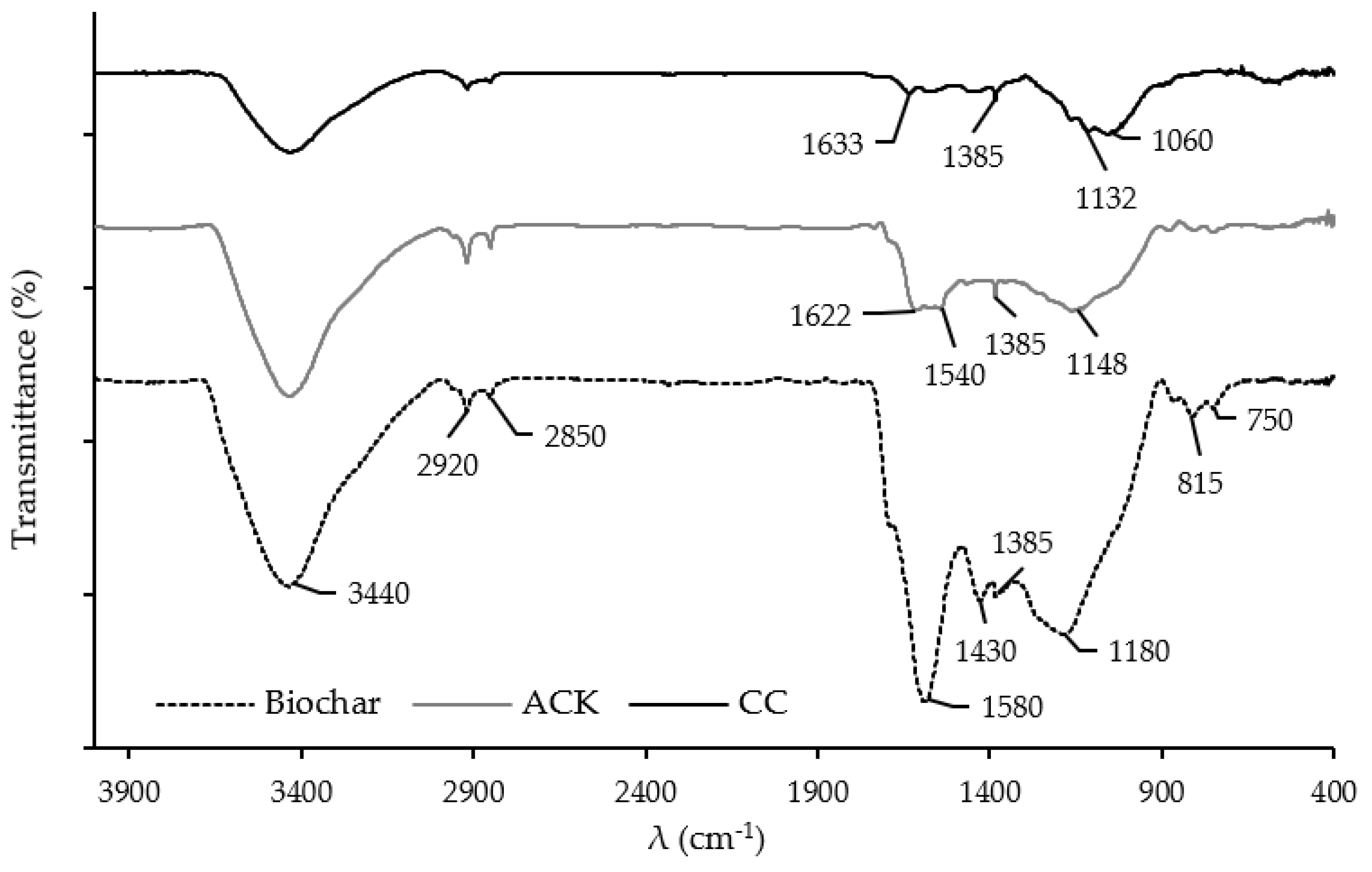
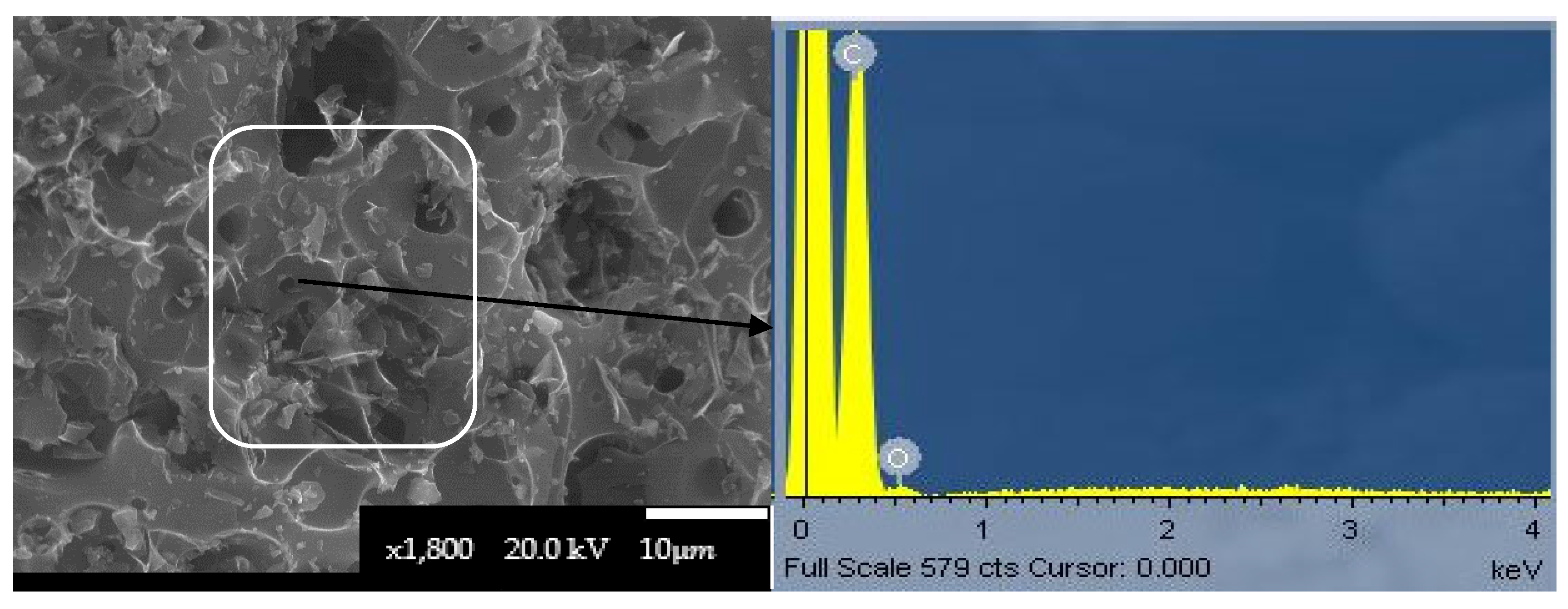

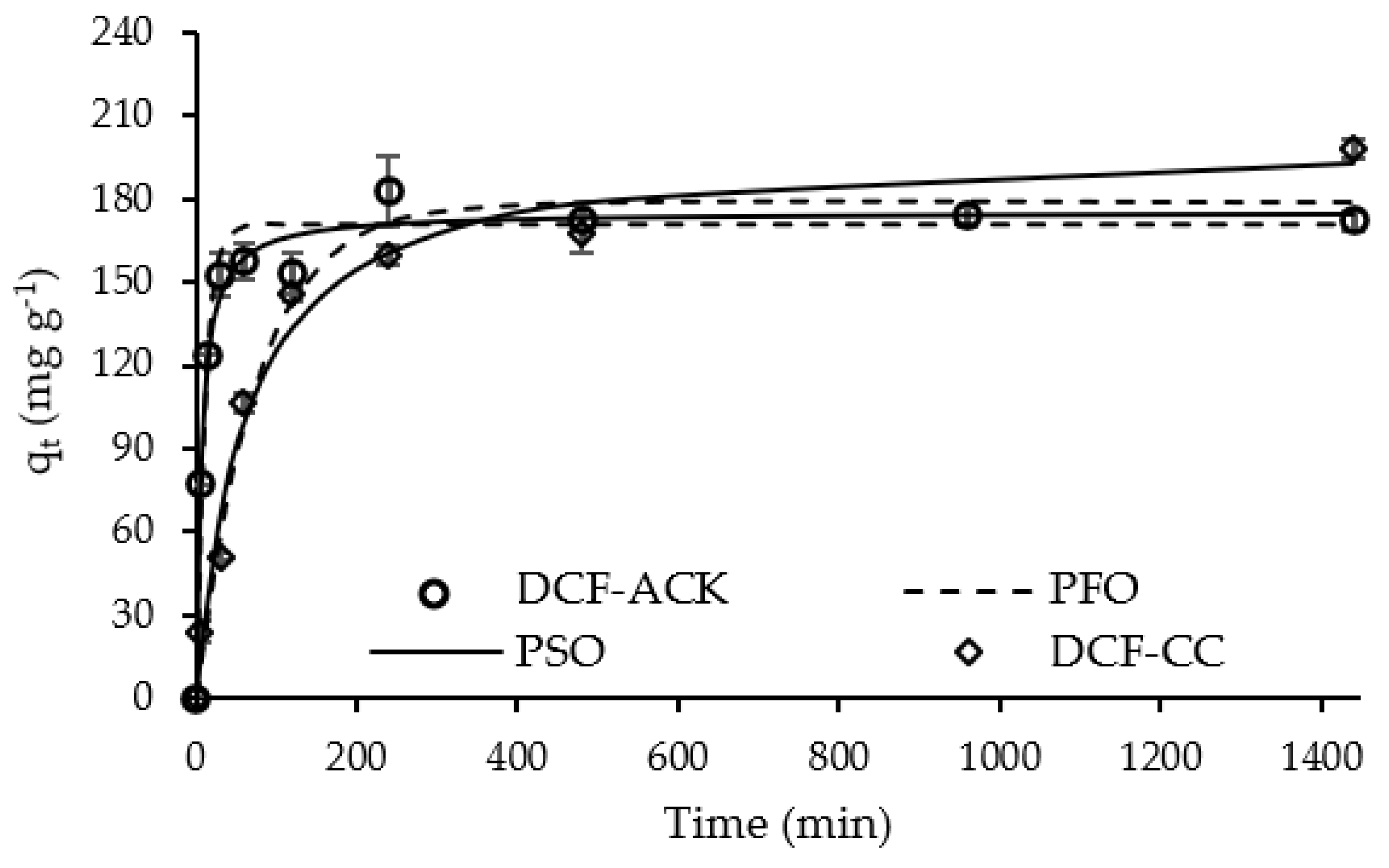
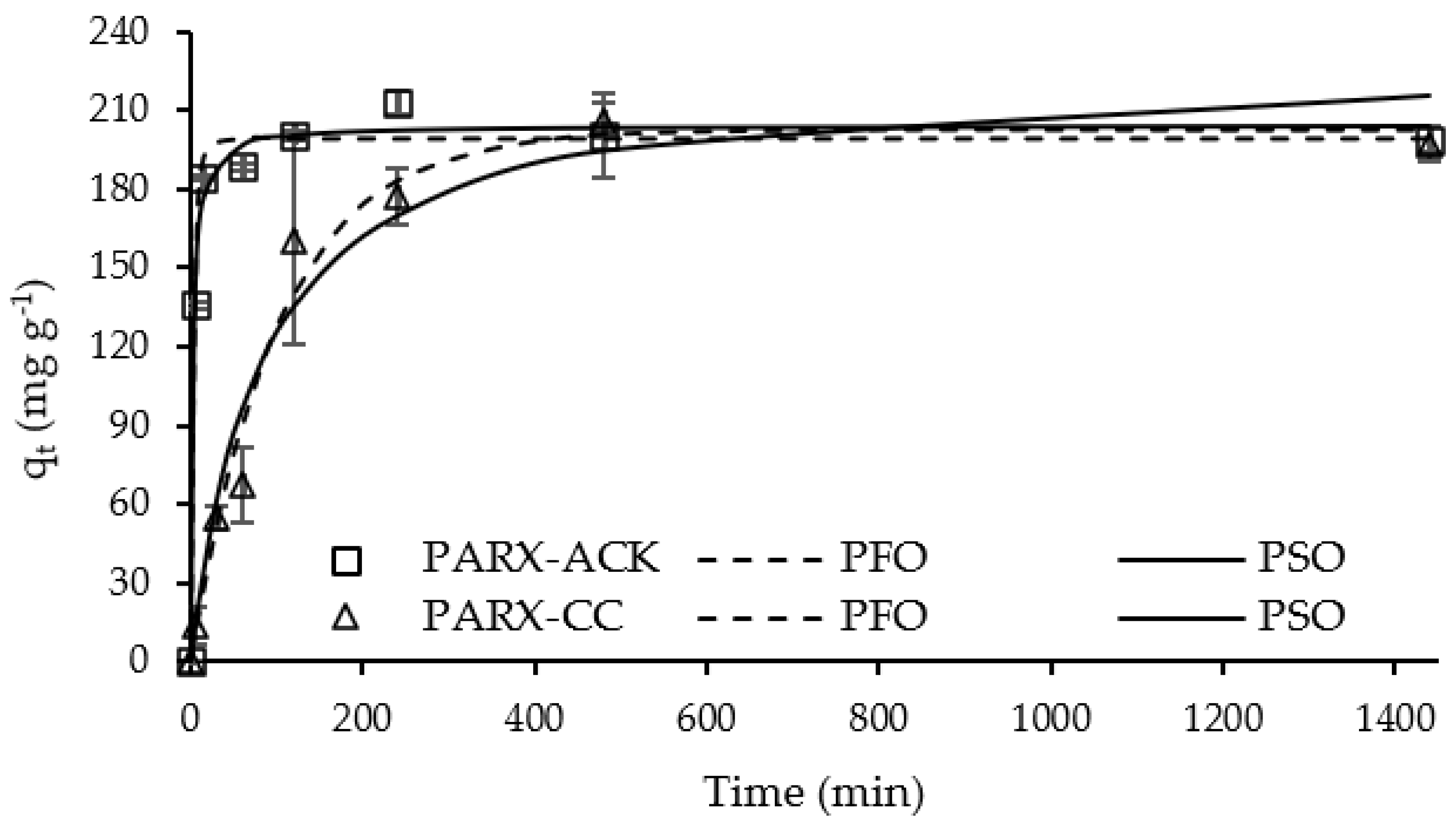

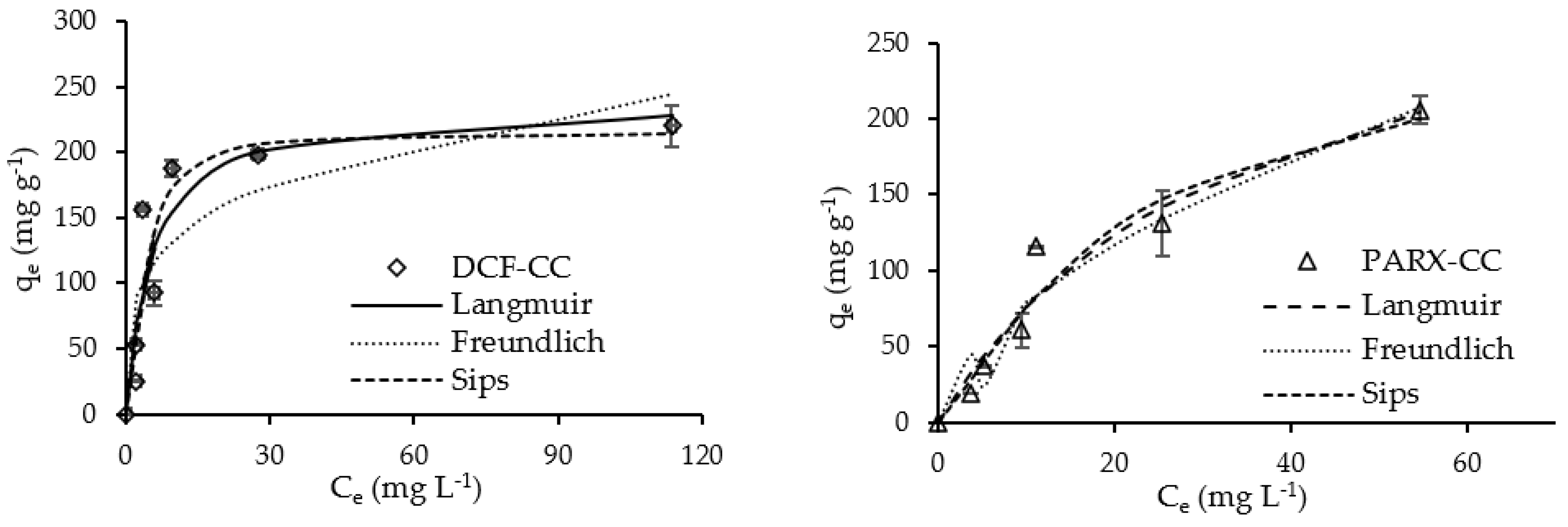


| Sample Name | Temperature (°C) | Activation Time (h) | Biochar:KOH Mass Ratio |
|---|---|---|---|
| Temperature effect | |||
| ACK700_1_1:1.5 | 700 | 1 | 1:1.5 |
| ACK800_1_1:1.5 | 800 | 1 | 1:1.5 |
| Mass ratio effect | |||
| ACK800_1_1:1 | 800 | 1 | 1:1 |
| ACK800_1_1:1.5 | 800 | 1 | 1:1.5 |
| ACK800_1_1:2 | 800 | 1 | 1:2 |
| Activation time effect | |||
| ACK800_1_1:2 | 800 | 1 | 1:2 |
| ACK800_2_1:2 | 800 | 2 | 1:2 |
| Sample Name | SBET (m2 g−1) | VT (cm3 g−1) | VMic (cm3 g−1) | VMes (cm3 g−1) |
|---|---|---|---|---|
| Biochar | <5.0 | - | - | - |
| CC a | 1030 | 0.56 | 0.30 | 0.26 |
| ACK700_1_1:1.5 | 1063 | 0.51 | 0.25 | 0.26 |
| ACK800_1_1:1.5 | 1542 | 0.76 | 0.33 | 0.43 |
| ACK800_1_1:1 | 1214 | 0.45 | 0.37 | 0.08 |
| ACK800_1_1:2 | 1624 | 0.74 | 0.40 | 0.34 |
| ACK800_2_1:2 | 678 | 0.35 | n.d. | n.d. |
| ANS a | Char | ACK | CC a | |
|---|---|---|---|---|
| C (wt.%) | 47.8 | 74.6 | 69.9 | 86.3 |
| H (wt.%) | 6.54 | 3.44 | 1.74 | 0.47 |
| N (wt.%) | 0.33 | 0.30 | 0.39 | <0.20 |
| S (wt.%) | <0.03 | <0.03 | 0.20 | 0.57 |
| O b (wt.%) | 45.2 | 21.4 | 26.9 | 6.76 |
| Ashes (wt.%) | 0.065 | 0.26 | 0.95 | 5.70 |
| pHPZC | - | - | 7.0 | 9.1 |
| CC | ACK | CC a | ACK | Assignment [39] |
|---|---|---|---|---|
| Binding Energy (eV) | Atomic Concentration % | |||
| 284.8 | 284.8 | 66.5 | 55.0 | Carom + Caliph |
| 286.2 | 286.2 | 11.5 | 15.9 | C-O |
| 287.4 | 287.6 | 6.3 | 7.8 | C=O |
| 288.9 | 289.0 | 3.8 | 4.4 | O-C=O |
| 290.2 | 290.5 | 3.1 | 3.1 | π→π* |
| 291.7 | 292.1 | 2.6 | 1.7 | |
| 530.8 | 531.0 | 0.8 | 1.7 | C=Oarom |
| 532.1 | 532.4 | 1.8 | 3.7 | C=Oalif |
| 533.2 | 533.8 | 2.0 | 2.7 | C-O |
| 534.6 | 535.4 | 0.9 | 1.2 | Isolated H2O |
| 536.0 | 537.0 | 0.7 | 0.7 | H2O |
| Atomic ratio | 14.1 | 8.3 | C/O | |
| 6.0 | 5.5 | π→π*/Ctotal | ||
| Sample | Carboxylic Acids | Carboxylic Anhydrides | Lactones | Total CO2 (±20 µmol g−1) | ||||||
| Tm (°C) | W (°C) | A (µmol g−1) | Tm (°C) | W (°C) | A (µmol g−1) | Tm (°C) | W (°C) | A (µmol g−1) | ||
| ACK | 278 | 200 | 308 | 138 | 172 | 191 | 655 | 172 | 234 | 738 |
| CC a | 220 | 219 | 179 | 498 | 242 | 126 | 754 | 242 | 99 | 390 |
| Sample | Carboxylic Anhydrides | Phenols | Carbonyls or Quinones | Total CO (±20 µmol g−1) | ||||||
| Tm (°C) | W (°C) | A (µmol g−1) | Tm (°C) | W (°C) | A (µmol g−1) | Tm (°C) | W (°C) | A (µmol g−1) | ||
| ACK | 469 | 172 | 191 | 641 | 151 | 482 | 802 | 151 | 582 | 1291 |
| CC a | 498 | 242 | 126 | 673 | 154 | 211 | 859 | 154 | 329 | 695 |
| DCF | PARX | |||
|---|---|---|---|---|
| ACK | CC a | ACK | CCa | |
| PFO model | ||||
| R2 | 0.972 | 0.976 | 0.989 | 0.980 |
| qe (mg g−1) | 171 | 179 | 199 | 202 |
| k1 (min−1) | 0.095 | 0.013 | 0.222 | 0.010 |
| PSO model | ||||
| R2 | 0.986 | 0.983 | 0.992 | 0.960 |
| qe (mg g−1) | 175 | 201 | 204 | 227 |
| k2 (g mg−1 min−1) | 9 × 10−4 | 1 × 10−4 | 0.002 | 5 × 10−5 |
| DCF | PARX | |||
|---|---|---|---|---|
| ACK | CC a | ACK | CC a | |
| Langmuir | ||||
| qm (mg g−1) | 217 | 239 | 276 | 330 |
| KL (L mg−1) | 0.2 | 0.2 | 0.2 | 0.03 |
| R2 | 0.964 | 0.841 | 0.965 | 0.948 |
| Freundlich | ||||
| KF [mg g−1 (mg L−1)n] | 82.5 | 74.0 | 102 | 20.9 |
| n (dimensionless) | 5.0 | 3.9 | 0.23 | 1.75 |
| R2 | 0.842 | 0.732 | 0.953 | 0.932 |
| Sips | ||||
| qm (mg g−1) | 217 | 214 | 275 | 260 |
| KS (L mg−1) | 0.099 | 0.097 | 0.043 | 0.024 |
| ns | 0.5 | 1.66 | 0.2 | 1.24 |
| R2 | 0.964 | 0.861 | 0.965 | 0.950 |
Publisher’s Note: MDPI stays neutral with regard to jurisdictional claims in published maps and institutional affiliations. |
© 2022 by the authors. Licensee MDPI, Basel, Switzerland. This article is an open access article distributed under the terms and conditions of the Creative Commons Attribution (CC BY) license (https://creativecommons.org/licenses/by/4.0/).
Share and Cite
Mokhati, A.; Benturki, O.; Benturki, A.; Fennouh, R.; Kecira, Z.; Bernardo, M.; Matos, I.; Lapa, N.; Ventura, M.; Soares, O.S.G.P.; et al. Conversion of Argan Nutshells into Novel Porous Carbons in the Scope of Circular Economy: Adsorption Performance of Emerging Contaminants. Appl. Sci. 2022, 12, 7607. https://doi.org/10.3390/app12157607
Mokhati A, Benturki O, Benturki A, Fennouh R, Kecira Z, Bernardo M, Matos I, Lapa N, Ventura M, Soares OSGP, et al. Conversion of Argan Nutshells into Novel Porous Carbons in the Scope of Circular Economy: Adsorption Performance of Emerging Contaminants. Applied Sciences. 2022; 12(15):7607. https://doi.org/10.3390/app12157607
Chicago/Turabian StyleMokhati, Asma, Oumessaâd Benturki, Asma Benturki, Radia Fennouh, Zoubida Kecira, Maria Bernardo, Inês Matos, Nuno Lapa, Márcia Ventura, Olívia Salomé G. P. Soares, and et al. 2022. "Conversion of Argan Nutshells into Novel Porous Carbons in the Scope of Circular Economy: Adsorption Performance of Emerging Contaminants" Applied Sciences 12, no. 15: 7607. https://doi.org/10.3390/app12157607
APA StyleMokhati, A., Benturki, O., Benturki, A., Fennouh, R., Kecira, Z., Bernardo, M., Matos, I., Lapa, N., Ventura, M., Soares, O. S. G. P., Do Rego, A. M. B., & Fonseca, I. (2022). Conversion of Argan Nutshells into Novel Porous Carbons in the Scope of Circular Economy: Adsorption Performance of Emerging Contaminants. Applied Sciences, 12(15), 7607. https://doi.org/10.3390/app12157607












